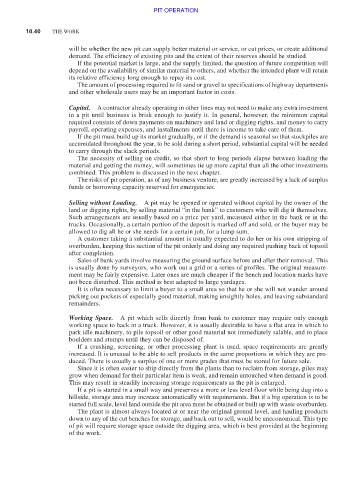Page 534 - Moving the Earth_ The Workbook of Excavation
P. 534
PIT OPERATION
10.40 THE WORK
will be whether the new pit can supply better material or service, or cut prices, or create additional
demand. The efficiency of existing pits and the extent of their reserves should be studied.
If the potential market is large, and the supply limited, the question of future competition will
depend on the availability of similar material to others, and whether the intended plant will retain
its relative efficiency long enough to repay its cost.
The amount of processing required to fit sand or gravel to specifications of highway departments
and other wholesale users may be an important factor in costs.
Capital. A contractor already operating in other lines may not need to make any extra investment
in a pit until business is brisk enough to justify it. In general, however, the minimum capital
required consists of down payments on machinery and land or digging rights, and money to carry
payroll, operating expenses, and installments until there is income to take care of them.
If the pit must build up its market gradually, or if the demand is seasonal so that stockpiles are
accumulated throughout the year, to be sold during a short period, substantial capital will be needed
to carry through the slack periods.
The necessity of selling on credit, so that short to long periods elapse between loading the
material and getting the money, will sometimes tie up more capital than all the other investments
combined. This problem is discussed in the next chapter.
The risks of pit operation, as of any business venture, are greatly increased by a lack of surplus
funds or borrowing capacity reserved for emergencies.
Selling without Loading. A pit may be opened or operated without capital by the owner of the
land or digging rights, by selling material “in the bank” to customers who will dig it themselves.
Such arrangements are usually based on a price per yard, measured either in the bank or in the
trucks. Occasionally, a certain portion of the deposit is marked off and sold, or the buyer may be
allowed to dig all he or she needs for a certain job, for a lump sum.
A customer taking a substantial amount is usually expected to do her or his own stripping of
overburden, keeping this section of the pit orderly and doing any required pushing back of topsoil
after completion.
Sales of bank yards involve measuring the ground surface before and after their removal. This
is usually done by surveyors, who work out a grid or a series of profiles. The original measure-
ment may be fairly expensive. Later ones are much cheaper if the bench and location marks have
not been disturbed. This method is best adapted to large yardages.
It is often necessary to limit a buyer to a small area so that he or she will not wander around
picking out pockets of especially good material, making unsightly holes, and leaving substandard
remainders.
Working Space. A pit which sells directly from bank to customer may require only enough
working space to back in a truck. However, it is usually desirable to have a flat area in which to
park idle machinery, to pile topsoil or other good material not immediately salable, and to place
boulders and stumps until they can be disposed of.
If a crushing, screening, or other processing plant is used, space requirements are greatly
increased. It is unusual to be able to sell products in the same proportions in which they are pro-
duced. There is usually a surplus of one or more grades that must be stored for future sale.
Since it is often easier to ship directly from the plants than to reclaim from storage, piles may
grow when demand for their particular item is weak, and remain untouched when demand is good.
This may result in steadily increasing storage requirements as the pit is enlarged.
If a pit is started in a small way and preserves a more or less level floor while being dug into a
hillside, storage area may increase automatically with requirements. But if a big operation is to be
started full scale, level land outside the pit area must be obtained or built up with waste overburden.
The plant is almost always located at or near the original ground level, and hauling products
down to any of the cut benches for storage, and back out to sell, would be uneconomical. This type
of pit will require storage space outside the digging area, which is best provided at the beginning
of the work.

